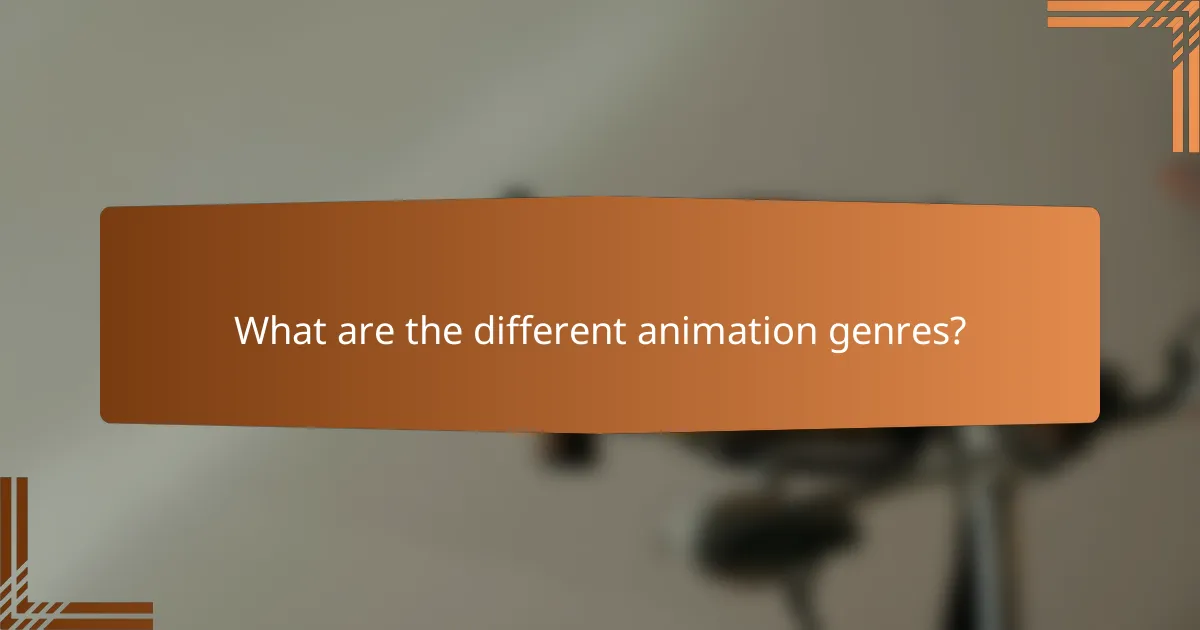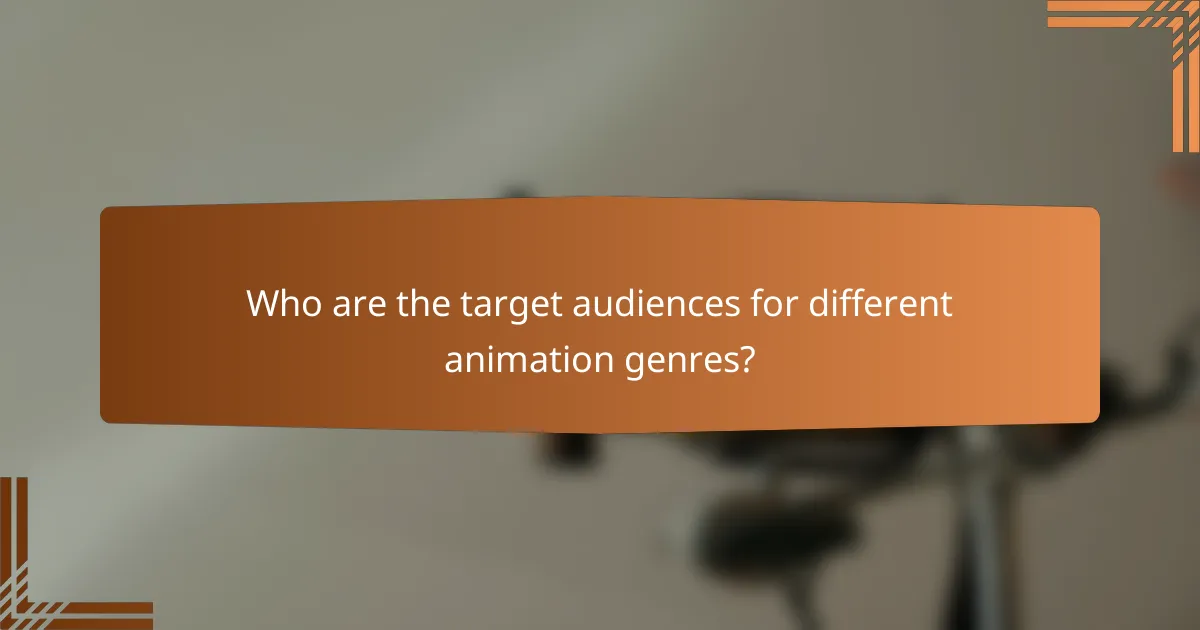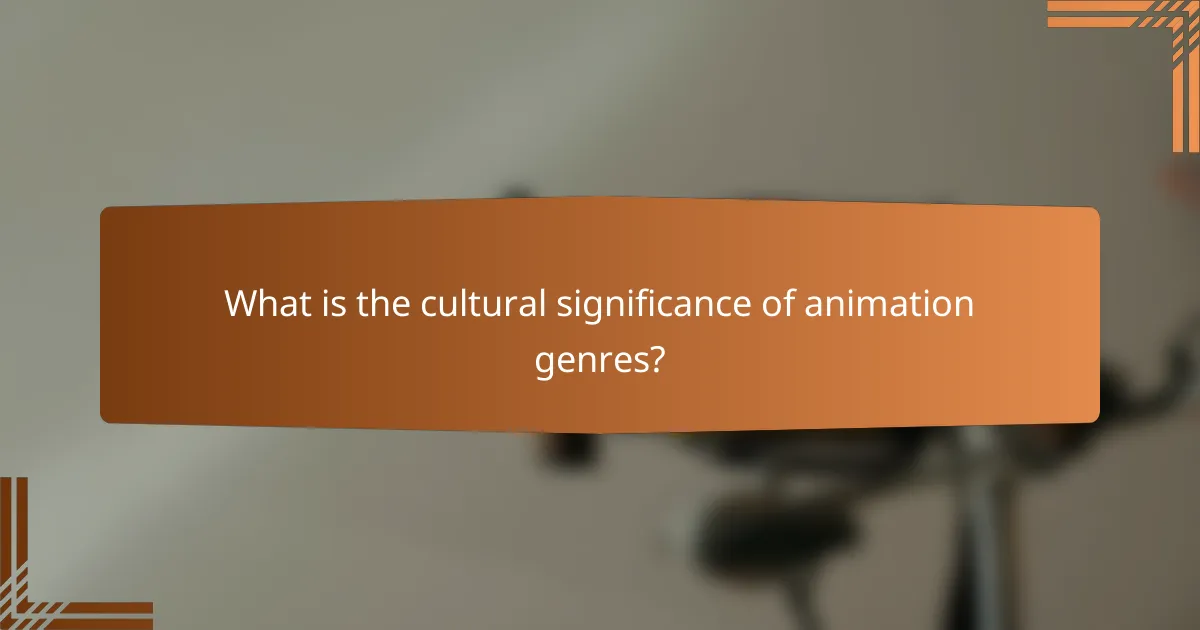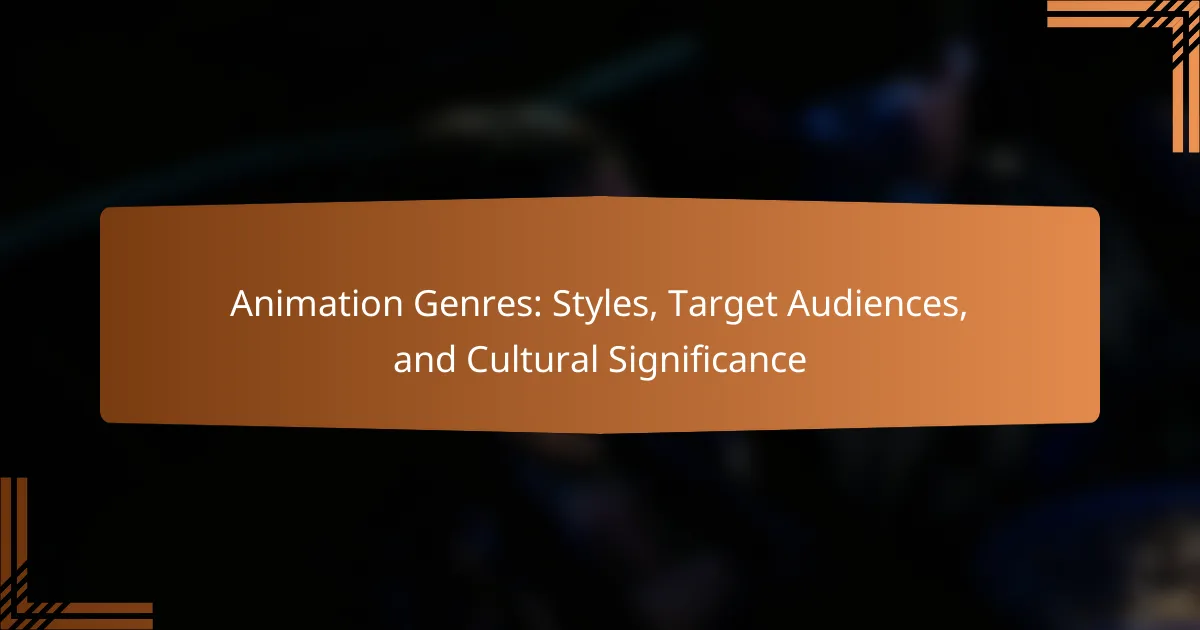Animation genres encompass various styles such as 2D animation, 3D animation, stop-motion, and computer-generated imagery (CGI), each serving distinct audiences and purposes. The article explores how these genres attract different demographics, including children, teenagers, and adults, based on their interests and age. It also highlights the cultural significance of animation, illustrating how genres reflect societal values and influence cultural trends. Additionally, the discussion includes the role of animation in promoting cultural exchange, particularly through the global impact of Japanese anime on Western animation styles.

What are the different animation genres?
The different animation genres include 2D animation, 3D animation, stop-motion, and computer-generated imagery (CGI). 2D animation features flat images and is often hand-drawn or created digitally. 3D animation utilizes models and computer software to create depth and realism. Stop-motion involves capturing physical objects in a sequence to create movement. CGI encompasses a broad range of techniques used to create visual content through computer graphics. Each genre serves various audiences and purposes, from entertainment to education.
How do animation genres differ from one another?
Animation genres differ in style, target audience, and thematic content. For instance, comedy animation often features exaggerated characters and humorous situations aimed at entertaining a broad audience. In contrast, drama animation focuses on emotional storytelling and character development, appealing to viewers seeking depth and relatability.
Additionally, genres like action animation emphasize fast-paced sequences and visual spectacle, often attracting younger audiences and fans of adventure. On the other hand, educational animation serves to inform and teach, typically targeting children or learners of all ages.
Cultural significance also plays a role in differentiating genres. For example, anime often reflects Japanese culture and values, while Western animation may showcase different societal norms. Each genre’s unique attributes contribute to its distinct identity within the animation landscape.
What are the defining characteristics of each animation genre?
Animation genres are categorized by distinct characteristics that define their style, audience, and storytelling approach. For example, traditional animation features hand-drawn techniques and often appeals to family audiences. CGI animation utilizes computer-generated imagery, allowing for more complex visuals and is popular in both children’s and [censured] content. Stop-motion animation involves physically manipulating objects and is known for its unique aesthetic, often attracting niche audiences. Anime, originating from Japan, is characterized by its colorful artwork and diverse themes, appealing to various demographics. Each genre also reflects cultural significance, with genres like educational animation focusing on learning and awareness. These defining traits help audiences identify and select animation styles that resonate with them.
How do cultural influences shape different animation genres?
Cultural influences significantly shape different animation genres by dictating themes, styles, and storytelling methods. Each culture has unique narratives and traditions that manifest in its animation. For example, Japanese anime often incorporates elements of Shinto and Buddhism, reflecting cultural beliefs. Western animation frequently emphasizes individualism and adventure, rooted in Western values.
Cultural context also determines visual styles. For instance, the vibrant colors and exaggerated expressions in Mexican animation highlight local folklore. In contrast, Scandinavian animation may utilize minimalistic designs to reflect cultural aesthetics.
Moreover, cultural influences affect target audiences. Family values in certain cultures lead to animations designed for children, while others may focus on [censured] themes. Historical events can also inspire genres, such as the impact of World War II on American animation.
Overall, cultural influences create diverse animation genres that resonate with specific audiences, enriching the global animation landscape.
What role do animation genres play in storytelling?
Animation genres significantly influence storytelling by shaping narrative structure and audience engagement. Each genre, such as comedy, drama, or fantasy, dictates the tone and style of the story. For example, comedy often employs humor and exaggeration to convey messages, while drama focuses on emotional depth and character development.
Genres also guide the visual aesthetics and character design, enhancing the viewer’s experience. A fantasy animation may feature vibrant colors and imaginative settings, while a horror animation might utilize darker tones and eerie visuals.
Furthermore, animation genres cater to specific target audiences. Children’s animations typically incorporate educational themes and moral lessons, while [censured] animations might explore complex social issues. This alignment with audience expectations enriches storytelling by making it relatable and impactful.
In summary, animation genres play a crucial role in storytelling by defining narrative style, guiding visual elements, and aligning with audience expectations.
How does genre influence narrative structure in animation?
Genre significantly influences narrative structure in animation by dictating themes, character development, and plot progression. Each genre has distinct conventions that shape storytelling techniques. For example, action animations often emphasize fast-paced sequences and conflict-driven plots. In contrast, comedies might focus on humor and character interactions, leading to episodic structures.
Dramatic animations typically explore deep emotional arcs and character backstories, which can result in a more linear narrative. Fantasy genres may incorporate world-building elements, allowing for non-linear storytelling and complex character relationships.
Evidence shows that genre conventions affect audience expectations and engagement. Research indicates that viewers anticipate specific narrative structures based on genre cues. For instance, a study by Smith et al. (2020) found that audiences prefer narratives that align with their genre expectations, enhancing overall satisfaction.
Thus, genre serves as a guiding framework that shapes how stories are told in animation, impacting both the narrative structure and viewer experience.
What themes are commonly explored in various animation genres?
Common themes explored in various animation genres include friendship, adventure, and self-discovery. These themes resonate across different styles, from children’s cartoons to [censured] animations. For example, friendship is a central theme in series like “My Little Pony,” emphasizing social connections. Adventure is prominent in films like “Up,” showcasing journeys and personal growth. Self-discovery is explored in “Inside Out,” where characters navigate emotions to understand themselves. Additionally, themes of family, love, and overcoming adversity frequently appear in animated narratives, reinforcing universal human experiences. These themes contribute to the emotional depth and relatability of animated works across diverse audiences.

Who are the target audiences for different animation genres?
The target audiences for different animation genres vary significantly. Children primarily engage with genres like educational and family animation. These genres often feature bright colors and simple narratives. Teenagers are attracted to genres such as anime and action-oriented animation. These often include complex themes and character development. Adults typically enjoy genres like [censured] animation and experimental animation. These genres often explore social issues and offer satire. Additionally, niche audiences exist for genres like horror and fantasy animation. These cater to specific interests and preferences. Overall, animation genres are designed to appeal to distinct demographics based on age and interests.
How do age demographics affect animation genre preferences?
Age demographics significantly influence animation genre preferences. Younger audiences tend to prefer genres like action, fantasy, and adventure. These genres often feature vibrant visuals and dynamic storytelling. In contrast, older demographics may gravitate towards genres such as drama and comedy. These genres often explore deeper narratives and character development.
Research indicates that children are drawn to animated content that includes humor and relatable characters. A study by the Pew Research Center found that animated films with strong moral lessons resonate well with younger viewers. Adults, however, often seek animation that reflects real-world issues or nostalgia.
For example, animated series like “The Simpsons” appeal to adults through satire and social commentary. Additionally, age influences viewing platforms. Younger audiences favor streaming services, while older viewers may prefer traditional television. This shift in platform preference further shapes genre engagement across different age groups.
What genres are most popular among children, teens, and adults?
Children most commonly enjoy genres such as animation, fantasy, and adventure. These genres captivate their imagination and offer engaging storytelling. Teens often gravitate towards genres like action, drama, and romance. These genres reflect their experiences and emotions. Adults typically prefer genres such as drama, thriller, and documentary. These genres often provide deeper narratives and complex themes. According to a 2021 survey by the Pew Research Center, 78% of children watch animated content regularly. For teens, 65% report enjoying action films. Among adults, 55% favor dramas and thrillers.
How do cultural backgrounds influence audience engagement with animation genres?
Cultural backgrounds significantly influence audience engagement with animation genres. Different cultures have unique storytelling traditions and visual aesthetics. These factors shape how audiences perceive and connect with animated content. For instance, Japanese anime often incorporates cultural themes and character archetypes that resonate with local viewers. Research shows that cultural familiarity enhances emotional engagement with animated narratives. A study by T. E. Smith in “Cultural Impact on Animation” highlights that culturally relevant themes increase viewer relatability. Additionally, animation styles vary across cultures, affecting audience preferences. Western animation often emphasizes humor and action, while Eastern styles may focus on emotional depth and moral lessons. Thus, cultural backgrounds play a crucial role in shaping audience engagement with animation genres.
What factors contribute to audience appeal in animation genres?
Audience appeal in animation genres is influenced by several key factors. Visual aesthetics play a crucial role; vibrant colors and unique art styles attract viewers. Storytelling depth also matters; compelling narratives resonate emotionally with audiences. Character development is essential; relatable characters create connections with viewers. Humor and entertainment value enhance engagement; comedic elements often draw larger audiences. Cultural relevance contributes to appeal; themes that reflect societal issues engage viewers on a deeper level. Target demographics influence preferences; different age groups favor distinct animation styles. Accessibility of content through various platforms increases reach; streaming services broaden audience exposure. These factors collectively shape the overall appeal of animation genres.
How do visual styles attract different audiences?
Visual styles attract different audiences by appealing to their preferences and cultural backgrounds. For instance, vibrant colors and exaggerated forms may attract younger viewers. In contrast, minimalistic designs often resonate with [censured] audiences seeking sophistication. Different genres utilize distinct visual styles to convey themes. For example, fantasy animations often use whimsical aesthetics, while horror animations employ darker tones and sharp contrasts. Research indicates that emotional responses to visual elements can influence audience engagement. A study by Hagtvedt and Brasel (2017) found that color saturation can affect mood and perception, impacting audience attraction. Thus, visual styles serve as a strategic tool to connect with diverse viewer demographics.
What role does humor play in audience preference for animation genres?
Humor significantly influences audience preference for animation genres. It enhances engagement and relatability, making content more enjoyable. Animated shows with humor often attract broader demographics. For instance, series like “The Simpsons” and “SpongeBob SquarePants” appeal to both children and adults. Research indicates that humor increases viewer retention and satisfaction. A study by the University of Southern California found that humorous content leads to higher emotional responses. This emotional connection can drive audience loyalty to specific genres. Overall, humor is a key factor in the popularity of various animation styles.

What is the cultural significance of animation genres?
Animation genres hold significant cultural value as they reflect societal values, beliefs, and issues. Each genre, such as anime, cartoons, or stop-motion, conveys unique narratives and aesthetics. These genres often cater to specific audiences, influencing cultural trends and shaping perceptions. For instance, anime frequently explores complex themes like identity and morality, resonating deeply with viewers. Cartoons, on the other hand, often utilize humor to address social issues, making them accessible to younger audiences. Historically, animation has served as a medium for cultural expression, evident in works like Disney’s “Snow White,” which influenced global perceptions of fairy tales. Furthermore, animation genres can promote cultural exchange, as seen in the global popularity of Japanese anime and its impact on Western animation styles. Overall, the cultural significance of animation genres lies in their ability to mirror and influence the cultural landscape.
How do animation genres reflect societal values and issues?
Animation genres reflect societal values and issues by mirroring cultural narratives and collective beliefs. Different genres address specific themes relevant to their time. For example, social issues like inequality are often depicted in animated films aimed at [censured] audiences. Family-friendly animations frequently promote values such as friendship and cooperation. Historical contexts influence the themes and character portrayals in various animations. For instance, wartime animations often convey patriotism or critique conflict. Research shows that animation can serve as a tool for social commentary, influencing public perception and discussion. The evolution of animation genres highlights shifting societal norms and challenges.
What examples illustrate the cultural impact of animation genres?
Anime has significantly influenced global pop culture through its unique storytelling and art style. For example, Studio Ghibli films like “Spirited Away” have won numerous awards and shaped perceptions of Japanese culture worldwide. Similarly, Disney’s animated features, such as “The Lion King,” have set cultural standards in storytelling and character development, impacting generations of viewers. The rise of Western animation, like “The Simpsons,” has also affected societal norms and humor, reflecting and shaping cultural conversations. These examples demonstrate how animation genres can resonate across cultures, promoting understanding and appreciation of diverse narratives.
How do animation genres evolve with changing cultural contexts?
Animation genres evolve in response to changing cultural contexts. This evolution reflects societal values, technological advancements, and audience preferences. For instance, the rise of social media has influenced short-form animation styles. These styles often prioritize humor and relatability to engage viewers quickly. Additionally, global events can shift themes within animation. For example, post-9/11, there was a noticeable increase in darker, more complex narratives. Cultural representation has also become more prominent in recent years. Animations now often showcase diverse characters and stories that resonate with a broader audience. This shift reflects a growing awareness of inclusivity in media. Historical events and technological shifts thus play crucial roles in shaping animation genres.
What is the global influence of various animation genres?
Various animation genres have a significant global influence on culture and entertainment. Genres like anime, Western animation, and stop-motion each contribute unique storytelling techniques and artistic styles. Anime has popularized specific themes and aesthetics worldwide, influencing fashion, art, and even social trends. Western animation, particularly through Disney and Pixar, has set standards for narrative structure and character development. Stop-motion animation, as seen in films like “Coraline,” showcases innovative techniques that inspire filmmakers globally. The international box office success of animated films highlights their universal appeal. For instance, “Frozen” grossed over $1.28 billion worldwide, demonstrating the genre’s impact on global audiences. Animation also fosters cross-cultural dialogue, as stories are adapted and localized for different markets. Overall, the global influence of animation genres shapes cultural narratives and artistic expression across diverse societies.
How do international animation genres differ from mainstream ones?
International animation genres often emphasize cultural storytelling and unique artistic styles, unlike mainstream animation. Mainstream animation typically focuses on broad appeal, standard narratives, and commercial success. International genres frequently incorporate traditional folklore, social issues, and regional aesthetics. For example, Japanese anime often explores complex themes and character development. In contrast, Western animation frequently prioritizes humor and family-friendly content. Additionally, international animations may utilize diverse animation techniques, such as stop-motion or hand-drawn styles. Mainstream animation tends to favor 3D computer-generated imagery for its efficiency and visual impact. These differences reflect varying cultural values and audience expectations across regions.
What trends are emerging in global animation genres?
Emerging trends in global animation genres include increased diversity in storytelling and representation. Animated content is now exploring a wider range of cultural narratives. This shift reflects a growing demand for inclusivity in media. Additionally, advancements in technology are influencing animation styles. Techniques like 3D animation and virtual reality are becoming more prevalent. The rise of streaming platforms is also shaping content creation. These platforms encourage innovative and niche genres. Moreover, collaborations across countries are leading to unique hybrid styles. This global exchange enriches the animation landscape significantly.
What best practices can creators follow when developing animation genres?
Creators should focus on understanding their target audience when developing animation genres. This involves researching audience preferences and demographics. Incorporating diverse storytelling techniques enhances relatability. Experimenting with various animation styles can attract different viewers. Collaborating with other artists brings fresh perspectives to the project. Maintaining a consistent visual and narrative style strengthens brand identity. Testing concepts through short films or pilots allows for audience feedback. Lastly, staying updated on industry trends ensures relevance in a competitive market.
How can understanding audience preferences enhance genre development?
Understanding audience preferences enhances genre development by aligning creative content with viewer expectations. This alignment improves engagement and satisfaction. For instance, research indicates that genres with strong audience connection see higher retention rates. A study by the University of Southern California found that animated films targeting specific demographics outperform others in box office revenue. By analyzing viewer feedback and trends, creators can innovate within genres. This innovation can lead to the emergence of new sub-genres. Ultimately, understanding preferences drives both commercial success and artistic evolution in animation.
What strategies can be employed to innovate within established animation genres?
Innovating within established animation genres can be achieved through several strategies. One effective approach is blending genres to create unique narratives. For instance, combining elements of fantasy and documentary can yield fresh storytelling perspectives. Another strategy is incorporating diverse cultural influences. This can introduce new visual styles and themes that resonate with wider audiences.
Utilizing advanced technology is also crucial. Techniques like virtual reality and augmented reality can enhance viewer engagement. Experimenting with animation techniques, such as 3D and stop-motion, can also create distinct aesthetics. Collaborating with artists from different disciplines can further inspire innovation. This cross-pollination of ideas often leads to original concepts.
Finally, addressing contemporary social issues in animation can resonate with audiences. This relevance can lead to deeper connections with viewers. These strategies collectively foster innovation while respecting the essence of established genres.
Animation genres encompass various styles, including 2D, 3D, stop-motion, and CGI, each serving distinct audiences and purposes. The article explores how these genres differ in terms of style, target demographic, thematic content, and cultural significance, highlighting the defining characteristics and narrative structures unique to each. It also examines the influence of cultural backgrounds on audience engagement and the evolving trends within global animation. Additionally, the article addresses best practices for creators in developing and innovating animation genres, emphasizing the importance of understanding audience preferences to enhance genre development.
